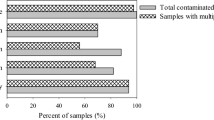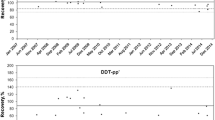Abstract
In this study, a muti-residue analysis method of 40 pesticides in five different categories of fruits in China was developed based on ultra-performance liquid chromatography-tandem mass spectrometry (UPLC–MS/MS). Five hundred real samples were analyzed and assessed for the dietary exposure risk. The sample treatment method was optimized by comparing four clean-up methods. The matrix effects of different fruits were evaluated. The analytical method was validated in terms of linearity, limit of detection (LOD), limit of quantification (LOQ), accuracy, and precision. The results showed that the optimal method was the treatment by clean up with ODS (octadecylsilane) and MgSO4. The matrix effect was the strongest in orange and weakest in apple. The LOD and LOQ of pesticides were 0.04–5.9 μg kg−1 and 0.13–19.5 μg kg−1, respectively. The recoveries at three spiked levels were ranged from 71.2 to 115.2% with the RSDs from 0.1 to 19.6%. Twenty-two pesticides were detected in 500 fruit samples from the major production regions of China, with concentrations ranging from 0.1 to 1930 μg kg−1. A total of 13, 10, 9, 8, and 4 pesticides were detected in peach, orange, grape, apple, and strawberry. Both the acceptable daily intake (ADI) and acute reference dose (ARfD) for all the detected pesticides were lower than 100%, indicating that the dietary intake risks are acceptable and would not pose potential health risks.




Similar content being viewed by others
References
Armbruster DA, Pry T (2008) Limit of blank, limit of detection and limit of quantitation. Clin Biochem Rev 29:S49–S52 https://www.ncbi.nlm.nih.gov/pmc/articles/PMC2556583/-b2-cbr29_s_pgs49
Besil N, Cesio V, Heinzen H et al (2017) Matrix effects and interferences of different citrus fruit coextractives in pesticide residue analysis using ultrahigh-performance liquid chromatography-high-resolution mass spectrometry. J Agric Food Chem 65:4819–4829 https://webofscience.clarivate.cn/wos/alldb/full-record/WOS:000403631100033
Bishwajit G, O’Leary DP, Ghosh S et al (2017) Association between depression and fruit and vegetable consumption among adults in South Asia. BMC Psychiatry 17:1–9. https://doi.org/10.1186/s12888-017-1198-1
Carneiro RP, Oliveira FAS, Madureira FD et al (2013) Development and method validation for determination of 128 pesticides in bananas by modified QuEChERS and UHPLC-MS/MS analysis. Food Control 33:413–423. https://doi.org/10.1016/j.foodcont.2013.02.027
Chen R, Xue XM, Wang GP et al (2021) Determination and dietary intake risk assessment of 14 pesticide residues in apples of China. Food Chem 351:129266. https://doi.org/10.1016/j.foodchem.2021.129266
Christia C, Bizani E, Christophoridis C et al (2015) Pesticide residues in fruit samples: comparison of different QuEChERS methods using liquid chromatography–tandem mass spectrometry. Environ Sci Pollut R 22:13167–13178. https://doi.org/10.1007/s11356-015-4456-0
Díez C, Feinberg M, Spörri SA et al (2016) Evaluation of quantification methods to compensate for matrix effects in the analysis of benzalkonium chloride and didecyldimethylammonium chloride in fruits and vegetables by LC-ESI-MS/MS. Food Anal Method 9:485–499. https://doi.org/10.1007/s12161-015-0216-5
EC/2002/657 (2002) Commission decision of 12 August 2002 implementing council directive 96/23/EC concerning the performance of analytical methods and the interpretation of results. Off J Eur Communities. https://commission.europa.eu/index_en?wt-search=yes
Fang L, Liao XF, Zhang Q et al (2021) An orthogonal experimental design and QuEChERS based UFLC-MS/MS for multi-pesticides and human exposure risk assessment in Honeysuckle. Ind Crop Prod 164:113384. https://doi.org/10.1016/j.indcrop.2021.113384
FAO (Food and Agriculture Organization) (2021) Crops and livestock products. http://www.fao.org/faostat/zh/#data/QCL
Farajzadeh MA, Feriduni B, Mogaddam MRA (2016) Development of a new extraction method based on counter current salting–out homogenous liquid–liquid extraction followed by dispersive liquid–liquid microextraction: application for the extraction and preconcentration of widely used pesticides from fruit juices. Talanta 146:772–779. https://doi.org/10.1016/j.talanta.2015.06.024
GB 23200.121-2021 (2021) National food safety standard-determination of 331 pesticides and metabolites residues in foods of plant origin-Liquid chromatography -tandem mass spectrometry method, National Standards of People’s Republic of China. http://down.foodmate.net/standard/yulan.php?itemid=97823
GB 2763-2021 (2021) National food safety standard-maximum residue limits for pesticides in food, National Standards of People’s Republic of China. http://down.foodmate.net/standard/yulan.php?itemid=97819
Han BJ, Huang HZ, He Y et al (2017) Determination of four pesticides residues in food products of animal origin using ultra-high performance liquid chromatography tandem mass spectrometry. Food Res Devt 38:130–134. https://doi.org/10.3969/j.issn.1005-6521.2017.20.027
Huang YS, Shi T, Luo X et al (2019) Determination of multi-pesticide residues in green tea with a modified QuEChERS protocol coupled to HPLC-MS/MS. Food Chem. 275:255–264. https://doi.org/10.1016/j.foodchem.2018.09.094
Istianto M, Emilda D (2021) The potency of citronella oil and clove oil for pest and disease control in tropical fruit plants. IOP Conf Ser: Earth Env 739(1):012064. https://doi.org/10.1088/1755-1315/739/1/012064
Jensen BH, Petersen A, Nielsen E et al (2015) Cumulative dietary exposure of the population of Denmark to pesticides. Food Chem Toxicol 83:300–307. https://doi.org/10.1016/j.fct.2015.07.002
Jiao WT, Xiao Y, Qian XS et al (2016) Optimized combination of dilution and refined QuEChERS to overcome matrix effects of six types of tea for determination eight neonicotinoid insecticides by ultra performance liquid chromatography– electrospray tandem mass spectrometry. Food Chem 210:26–34. https://doi.org/10.1016/j.foodchem.2016.04.097
Lehotay SJ (2011) QuEChERS sample preparation approach for mass spectrometric analysis of pesticide residues in foods. Methods Mol Biol 747:65–91. https://doi.org/10.1007/978-1-61779-136-9_4
Li MM, Dai C, Wang FZ et al (2017) Chemometric-assisted QuEChERS extraction method for post-harvest pesticide determination in fruits and vegetables. Sci Rep 7:42489. https://doi.org/10.1038/srep42489
Li ZX, Nie JY, Yan Z et al (2015) Risk assessment and ranking of pesticide residues in Chinese pears. J Integr Agr 14(11):2328–2339. https://doi.org/10.1016/S2095-3119(15)61124-8
Li ZX, Nie JY, Yan Z et al (2016) Cumulative risk assessment of the exposure to pyrethroids through fruits consumption in China-based on a 3-year investigation. Food Chem Toxicol 96:234–243. https://doi.org/10.1016/j.fct.2016.08.012
Mathias PC, Hayden JA, Laha TJ et al (2014) Evaluation of matrix effects using a spike recovery approach in a dilute-and-inject liquid chromatography–tandem mass spectrometry opioid monitoring assay. Clin Chim Acta 437:38–42. https://doi.org/10.1016/j.cca.2014.06.023
Mnyandu HM, Mahlambi PN (2021) Optimization and application of QuEChERS and SPE methods followed by LC-PDA for the determination of triazines residues in fruits and vegetables from Pietermaritzburg local supermarkets. Food Chem 360:129818. https://doi.org/10.1016/j.foodchem.2021.129818
Muehlwald S, Buchner N, Kroh LW (2018) Investigating the causes of low detectability of pesticides in fruits and vegetables analysed by high–performance liquid chromatography–Time–of–flight. J Chromatogr A 1542:37–49. https://doi.org/10.1016/j.chroma.2018.02.011
Muñoz-Labrador A, Moreno R, Villamiel M et al (2018) Preparation of citrus pectin gels by power ultrasound and its application as an edible coating in strawberries. J Sci Food Agric 98(13):4866–4875. https://doi.org/10.1002/jsfa.9018
NBSC (National Bureau of Statistics of China) (2022) https://data.stats.gov.cn/easyquery.htm?cn=C01
Nie JY, Li ZX, Liu CD et al (2014) Risk assessment of pesticide residues in apples. Scientia Agric Sinica 47:3655–3667 http://en.cnki.com.cn/Article_en/CJFDTOTAL-ZNYK201418013.htm
Noegrohati S, Hernadi E, Asviastuti S (2018) Matrix effect evaluation and method validation of azoxystrobin and difenoconazole residues in red flesh dragon fruit (Hylocereus polyrhizus) matrices using QuEChERS sample preparation methods followed by LC–MS/MS determination. Bull Environ Contam Toxicol 100(6):821–826. https://doi.org/10.1007/s00128-018-2317-5
Pang RL, Cheng X, Fang JB et al (2015) Study on the condition of determination of main organic acids in fruits by ion exclusion chromatography. The. Food Ind 36:261–265 http://en.cnki.com.cn/Article_en/CJFDTOTAL-SPGY201504080.htm
Picó Y, Fernández M, Ruiz MJ et al (2007) Current trends in solid-phase-based extraction techniques for the determination of pesticides in food and environment. J Biochem Biophys Methods 70(2):117–131. https://doi.org/10.1016/j.jbbm.2006.10.010
Praveen K, Rúbies A, Centrich F et al (2014) A false positive case due to matrix interference in the analysis of ronidazole residues in muscle tissue using LC–MS/MS. Meat Sci 97:214–219. https://doi.org/10.1016/j.meatsci.2014.02.004
Reemtsma T, Alder L, Banasiak U (2013) A multimethod for the determination of 150 pesticide metabolites in surface water and groundwater using direct injection liquid chromatography-mass spectrometry. J Chromatogr A 1271:95–104. https://doi.org/10.1016/j.chroma.2012.11.023
Sandoval-Insausti H, Chiu YH, Lee DH et al (2021) Intake of fruits and vegetables by pesticide residue status in relation to cancer risk. Envir Int 156:106744. https://doi.org/10.1016/j.envint.2021.106744
SANTE/11312/2021 (2021) Analytical quality control and method validation procedures for pesticide residues analysis in food and feed. Available online: https://www.accredia.it/en/documento/guidance-sante-11312-2021-analytical-quality-control-and-method-validation-procedures-for-pesticide-residues-analysis-in-food-and-feed/
Schürmann A, Dvorak V, Crüzer C et al (2009) False-positive liquid chromatography/tandem mass spectrometric confirmation of sebuthylazine residues using the identification points system according to EU directive 2002/657/EC due to a biogenic insecticide in tarragon. Rapid Commun Mass Spectrom 23:1196–1200. https://doi.org/10.1002/rcm.3982
Seah MP, Shard AG (2018) The matrix effect in secondary ion mass spectrometry. Appl Surf Sci 439:605–611. https://doi.org/10.1016/j.apsusc.2018.01.065
Shimelis O, Yang YH, Stenerson K et al (2007) Evaluation of a solid-phase extraction dual-layer carbon/primary secondary amine for clean-up of fatty acid matrix components from food extracts in multiresidue pesticide analysis. J Chromatogr A 1165:18–25. https://doi.org/10.1016/j.chroma.2007.07.037
Skillman B, Kerrigan S (2021) Identification of Suvorexant in blood using LC-MS-MS: important considerations for matrix effects and quantitative interferences in targeted assays. J Anal Toxicol 44(3):245–255. https://doi.org/10.1093/jat/bkz083
Stachniuk A, Fornal E (2016) Liquid chromatography-mass spectrometry in the analysis of pesticide residues in food. Food Anal Methods 9:1654–1665. https://doi.org/10.1007/s12161-015-0342-0
Szpyrka E, Kurdziel A, Matyaszek A et al (2015) Evaluation of pesticide residues in fruits and vegetables from the region of south-eastern Poland. Food Control 48:137–142. https://doi.org/10.1016/j.foodcont.2014.05.039
Vargas-Pérez M, Marín-Sáez J, González FJE et al (2019) Optimization and establishment of QuEChERS based method for determination of propoxycarbazone and its metabolite in food commodities by liquid chromatography coupled to tandem mass spectrometry. Food Chem 274:429–433. https://doi.org/10.1016/j.foodchem.2018.08.135
Wang N (2018) Determination of pesticide residues in foods using liquid chromatography-triple quadriipole linear ion trap mass spectrometry, MSc thesis, Shandong University, Jinan, China. (in Chinese). https://kns.cnki.net/kcms2/article/abstract?v=phUvsea1i7YcrwRapf7vcE90IL3MxCWEM-B837JuaJ_Ux9nS8NCXpX74yq_NbAUWYCX1KOVUgUga2KvRylBLfiP2FBs65c3qnp5cZ8vQLVANcUk-YMAo88SvO_5ZzTYDJ_D0nae7mwFB4svWmYMKXw==&uniplatform=NZKPT&language=CHS
Wang TL, Zhong MM, Lu ML et al (2021) Development of a high–throughput multi-residue method for analysis of common pesticides in aquatic environments by automated online solid phase extraction coupled with LC-MS/MS. Anal methods : Adv Methods Appl 13:3160–3171. https://doi.org/10.1039/d1ay00157d
WHO (World Health Organization) (2021) Dietary exposure assessment of chemicals in food: report of a joint FAO/WHO consultation. https://apps.who.int/pesticide-residues-jmpr-database
WHO (World Health Organization) (2023) Global Environment Monitoring System (GEMS) / Food Contamination Monitoring and Assessment Programme. https://www.who.int/teams/nutrition-and-food-safety/databases/global-environment-monitoring-system-food-contamination
Xu XB, Feng TT, Zhang J et al (2018) A rapid clean-up method for the quantitation of 5-hydroxymethyl-2-furaldehyde in thermally treated abalone (Haliotis discus) muscle by HPLC-MS/MS. Anal Methods 10:5091–5096. https://doi.org/10.1039/c8ay01426d
Yan M, Cheng K, Yue Q et al (2016) Farm and product carbon footprints of China’s fruit production–life cycle inventory of representative orchards of five major fruits. Environ. Sci Pollut R 23:4681–4691. https://doi.org/10.1007/s11356-015-5670-5
Yan Z, Nie JY, Xu GF et al (2014) Effects of four kinds of purification methods for determination of 19 pesticide residues in substrates of different pigments analyzed by ultra performance liquid chromatography–tandem mass spectrometry. J Instruml Anal 33:1000–1009. https://doi.org/10.3969/j.issn.1004-4957.2014.09.004
Ye ML, Nie JY, Li ZX et al (2016) Health risks of consuming apples with carbendazim, imidacloprid, and thiophanatemethyl in the Chinese population: risk assessment based on a nonparametric probabilistic evaluation model. Hum Ecol Risk Assess: An Int J 22(4):1106–1121. https://doi.org/10.1080/10807039.2015.1138091
Zhang HL, Wan JH, Li L et al (2017) Determination of 103 pesticides and their main metabolites in animal origin food by QuEChERS and liquid chromatography–tandem mass spectrometry. Food Anal Methods 10:1826–1843. https://doi.org/10.1007/s12161-016-0736-7
Zhang YD, Si WS, Chen L et al (2021) Determination and dietary risk assessment of 284 pesticide residues in local fruit cultivars in Shanghai, China. Sci Rep 11:9681. https://doi.org/10.1038/s41598-021-89204-5
Funding
This research was funded by the Shandong Key R&D Plan (Agricultural Variety Project) (2022LZGCQY008), Scientific Research Foundation for High Level Talents of Qingdao Agricultural University (665-1120015), China Agriculture Research System of MOF and MARA (CARS-27), and the Science and Technology Innovation Program of the Chinese Academy of Agricultural Science (CAAS-ASTIP).
Author information
Authors and Affiliations
Contributions
Zhen Yan: conceptualization, methodology, investigation, formal analysis, writing — original draft, and writing — review and editing. Jiyun Nie: conceptualization, formal analysis, funding acquisition, project administration, and writing — review and editing. Yang Cheng: read, review, and editing. Lingxi Han: review and editing. Saqib Farooq: investigation and review.
Corresponding author
Ethics declarations
Ethics approval
Not applicable.
Consent to participate
Not applicable.
Consent for publication
Not applicable.
Competing interests
The authors declare no competing interests.
Additional information
Responsible Editor: Ester Heath
Publisher’s Note
Springer Nature remains neutral with regard to jurisdictional claims in published maps and institutional affiliations.
Rights and permissions
Springer Nature or its licensor (e.g. a society or other partner) holds exclusive rights to this article under a publishing agreement with the author(s) or other rightsholder(s); author self-archiving of the accepted manuscript version of this article is solely governed by the terms of such publishing agreement and applicable law.
About this article
Cite this article
Yan, ., Nie, J., Cheng, Y. et al. Method development, validation, and risk assessment of multiple pesticide residues of fruits in China. Environ Sci Pollut Res 31, 18826–18841 (2024). https://doi.org/10.1007/s11356-024-32198-0
Received:
Accepted:
Published:
Issue Date:
DOI: https://doi.org/10.1007/s11356-024-32198-0




